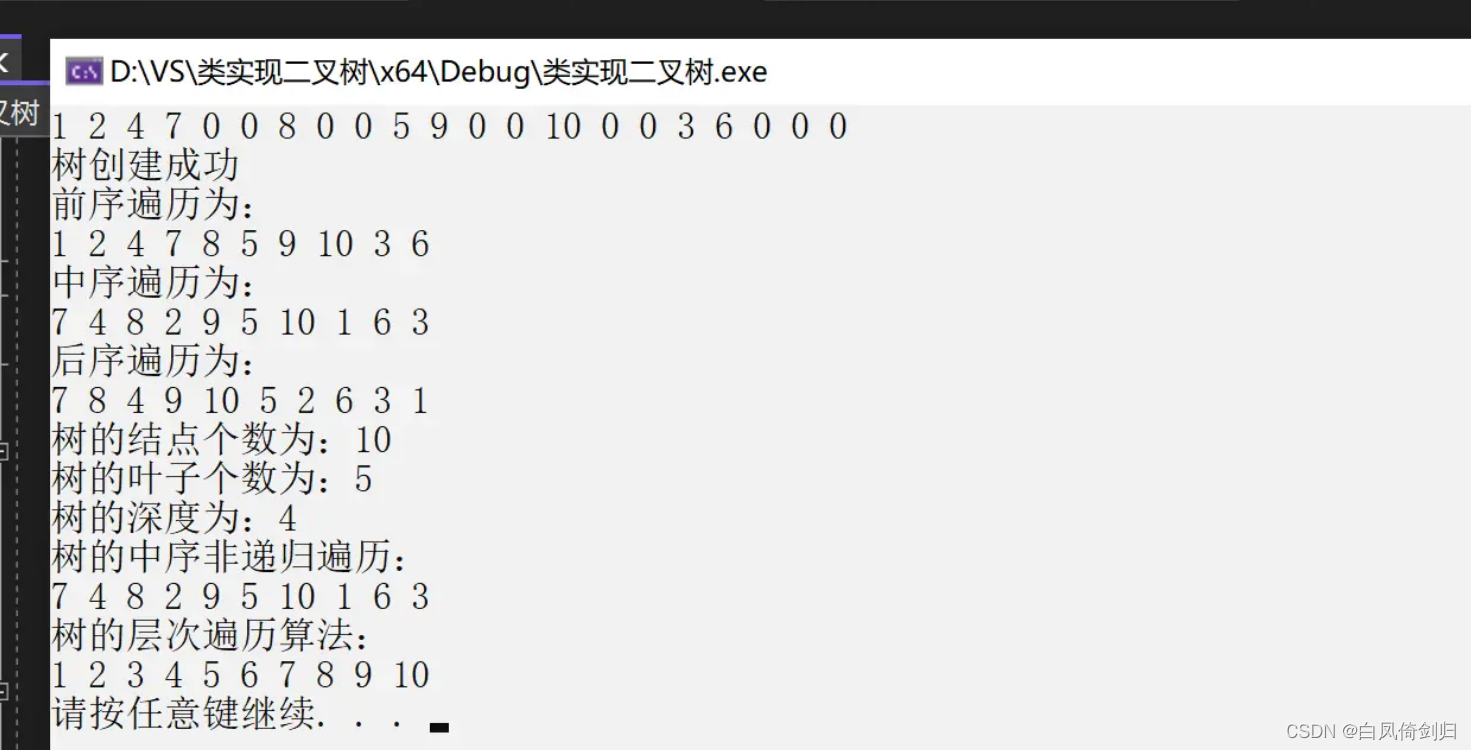二叉树是什么?
二叉树(Binary tree)是树形结构的一个重要类型。许多实际问题抽象出来的数据结构往往是二叉树形式,即使是一般的树也能简单地转换为二叉树,而且二叉树的存储结构及其算法都较为简单,因此二叉树显得特别重要。二叉树特点是每个节点最多只能有两棵子树,且有左右之分
思路:
首先,需要创建一个BTNode的结点,结点包含了数据,两个指针——lchild和rchild,再一个BTNode的构造函数,来初始化结点
接着,创建二叉树的类,类包含了头结点,以及各函数的实现操作。(初始化函数、创建树函数、遍历函数、求树的结点个数、求树的叶子数、求树的深度)
代码如下:
using namespace std;
typedef int Element;
//定义结点
struct BTNode {
Element data;
BTNode* lchild;
BTNode* rchild;
//结构体的构造函数
BTNode(Element number) {
data = number;
lchild = NULL;
rchild = NULL;
}
};
//定义二叉树类
class Btree {
public:
BTNode* Root;
//初始化创建树头
void Init() {
Root = CreatBTree();
cout << "树创建成功" << endl;
}
//创建树(前序)
BTNode* CreatBTree() {
BTNode* p;
Element number;
cin >> number;
if (number == 0)
p = NULL;
else {
p = new BTNode(number);
p->lchild = CreatBTree();
p->rchild = CreatBTree();
}
return p;
}
//前序遍历
void preOrderTraverse(BTNode *root) {
if (root) {
cout << root->data << " ";
preOrderTraverse(root->lchild);
preOrderTraverse(root->rchild);
}
}
//中序遍历
void inOrderTraverse(BTNode* root) {
if (root) {
inOrderTraverse(root->lchild);
cout << root->data << " ";
inOrderTraverse(root->rchild);
}
}
//后序遍历
void lastOrderTraverse(BTNode* root) {
if (root) {
lastOrderTraverse(root->lchild);
lastOrderTraverse(root->rchild);
cout << root->data << " ";
}
}
//求叶子结点个数
int LeafNum(BTNode* root) {
if (root == NULL) {
return 0;
}
else if (root->lchild == NULL && root->rchild == NULL)
return 1;
else
return LeafNum(root->lchild) + LeafNum(root->rchild);
}
//求树的结点个数
int BTNodeNum(BTNode* root) {
if (root == NULL)
return 0;
else
return BTNodeNum(root->lchild) + BTNodeNum(root->rchild) + 1;
}
//求树的深度
int TreeDepth(BTNode* root) {
if (root == NULL)
return 0;
int left = TreeDepth(root->lchild);
int right = TreeDepth(root->rchild);
return left > right ? left + 1 : right + 1;
}
};
int main()
{
Btree T;
//初始化
T.Init();
//遍历
cout << "前序遍历为:" << endl;
T.preOrderTraverse(T.Root);
cout << endl;
cout << "中序遍历为:" << endl;
T.inOrderTraverse(T.Root);
cout << endl;
cout << "后序遍历为:" << endl;
T.lastOrderTraverse(T.Root);
cout << endl;
//树的结点个数
cout << "树的结点个数为:";
int nodenum = T.BTNodeNum(T.Root);
cout << nodenum << endl;
//树的叶子个数
cout << "树的叶子个数为:";
int leaves = T.LeafNum(T.Root);
cout << leaves << endl;
//树的深度为:
cout << "树的深度为:";
int depth = T.TreeDepth(T.Root);
cout << depth << endl;
system("pause");
cout << endl;
}二叉树的非递归算法1——中序遍历非递归算法:
步骤介绍:
1.初始化一个空栈s,指针p指向根节点
2.申请一个空间来存放栈顶弹出的元素
3.当p非空或栈s非空时,循环以下步骤:
(一)如果p非空,入栈p结点,p指向p的左孩子
(二)如果p为空,则弹出栈顶元素并cout,p指向q的右孩子
void Traverse(BTNode* root) {
//创建栈
stack<BTNode*>s;
BTNode* p = root;
BTNode* q = NULL;
while (p || !empty(s)) {
if (p) {
s.push(p);
p = p->lchild;
}
else {
q = s.top();
cout << q->data << " ";
s.pop();
p = q->rchild;
}
}
}二叉树的非递归算法2——层次遍历二叉树:
步骤介绍:
1.将根节点入队;
2.若队列不为空时,出队队头结点p,进行以下循环:
(一)若p有左孩子(左孩子不为空),入队它的左孩子
(二)若p有右孩子(右孩子不为空),入队它的右孩子
void LevelOrder(BTNode* root) {
//创建队列
queue<BTNode*>q;
BTNode* p;
//先入队头结点
q.push(root);
//队不为空
while (!q.empty()) {
//取队头
p = q.front();
q.pop();
cout << p->data << " ";
//左孩子不为空
if (p->lchild != NULL) {
q.push(p->lchild);
}
//右孩子不为空
if (p->rchild != NULL) {
q.push(p->rchild);
}
}
}代码总和(2023.1.4更新版)
#include<stack>
#include<queue>
using namespace std;
typedef int Element;
//定义结点
struct BTNode {
Element data;
BTNode* lchild;
BTNode* rchild;
//结构体的构造函数
BTNode(Element number) {
data = number;
lchild = NULL;
rchild = NULL;
}
};
//定义二叉树类
class Btree {
public:
BTNode* Root;
//初始化创建树头
void Init() {
Root = CreatBTree();
cout << "树创建成功" << endl;
}
//创建树(前序)
BTNode* CreatBTree() {
BTNode* p;
Element number;
cin >> number;
if (number == 0)
p = NULL;
else {
p = new BTNode(number);
p->lchild = CreatBTree();
p->rchild = CreatBTree();
}
return p;
}
//前序遍历
void preOrderTraverse(BTNode *root) {
if (root) {
cout << root->data << " ";
preOrderTraverse(root->lchild);
preOrderTraverse(root->rchild);
}
}
//中序遍历
void inOrderTraverse(BTNode* root) {
if (root) {
inOrderTraverse(root->lchild);
cout << root->data << " ";
inOrderTraverse(root->rchild);
}
}
//后序遍历
void lastOrderTraverse(BTNode* root) {
if (root) {
lastOrderTraverse(root->lchild);
lastOrderTraverse(root->rchild);
cout << root->data << " ";
}
}
//求叶子结点个数
int LeafNum(BTNode* root) {
if (root == NULL) {
return 0;
}
else if (root->lchild == NULL && root->rchild == NULL)
return 1;
else
return LeafNum(root->lchild) + LeafNum(root->rchild);
}
//求树的结点个数
int BTNodeNum(BTNode* root) {
if (root == NULL)
return 0;
else
return BTNodeNum(root->lchild) + BTNodeNum(root->rchild) + 1;
}
//求树的深度
int TreeDepth(BTNode* root) {
if (root == NULL)
return 0;
int left = TreeDepth(root->lchild);
int right = TreeDepth(root->rchild);
return left > right ? left + 1 : right + 1;
}
//中序遍历非递归
void Traverse(BTNode* root) {
//创建栈
stack<BTNode*>s;
BTNode* p = root;
BTNode* q = NULL;
while (p || !empty(s)) {
if (p) {
s.push(p);
p = p->lchild;
}
else {
q = s.top();
cout << q->data << " ";
s.pop();
p = q->rchild;
}
}
}
//二叉树层次遍历算法
void LevelOrder(BTNode* root) {
//创建队列
queue<BTNode*>q;
BTNode* p;
//先入队头结点
q.push(root);
//队不为空
while (!q.empty()) {
//取队头
p = q.front();
q.pop();
cout << p->data << " ";
//左孩子不为空
if (p->lchild != NULL) {
q.push(p->lchild);
}
//右孩子不为空
if (p->rchild != NULL) {
q.push(p->rchild);
}
}
}
};
int main()
{
Btree T;
//初始化
T.Init();
//遍历
cout << "前序遍历为:" << endl;
T.preOrderTraverse(T.Root);
cout << endl;
cout << "中序遍历为:" << endl;
T.inOrderTraverse(T.Root);
cout << endl;
cout << "后序遍历为:" << endl;
T.lastOrderTraverse(T.Root);
cout << endl;
//树的结点个数
cout << "树的结点个数为:";
int nodenum = T.BTNodeNum(T.Root);
cout << nodenum << endl;
//树的叶子个数
cout << "树的叶子个数为:";
int leaves = T.LeafNum(T.Root);
cout << leaves << endl;
//树的深度为:
cout << "树的深度为:";
int depth = T.TreeDepth(T.Root);
cout << depth << endl;
//树的中序非递归遍历
cout << "树的中序非递归遍历:" << endl;
T.Traverse(T.Root);
cout << endl;
//树的层次遍历算法
cout << "树的层次遍历算法:" << endl;
T.LevelOrder(T.Root);
cout << endl;
system("pause");
cout << endl;
}结果测试:


























 623
623











 被折叠的 条评论
为什么被折叠?
被折叠的 条评论
为什么被折叠?










